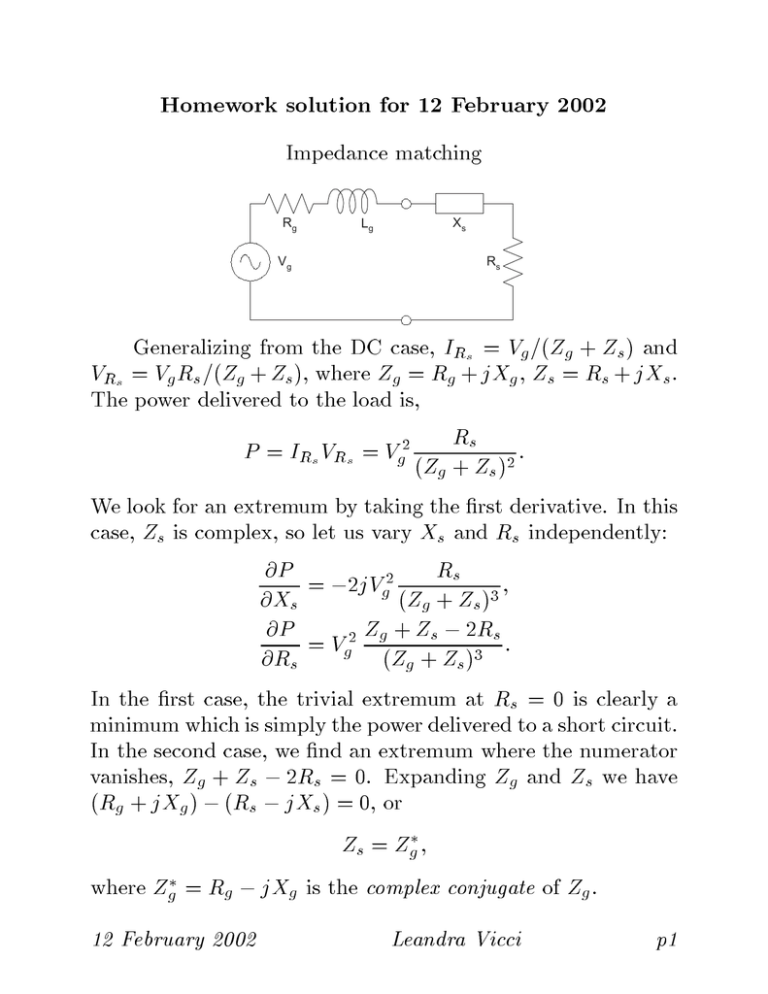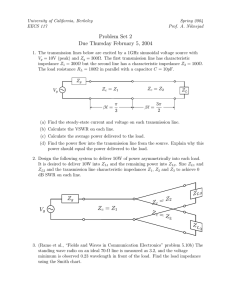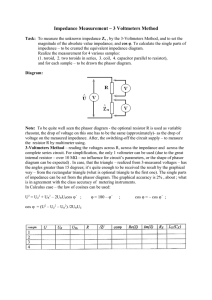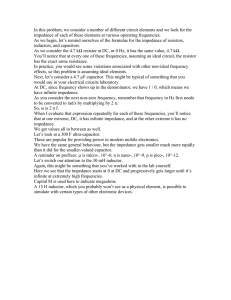Homework solution for 12 February 2002
advertisement

Homework solution for 12 February 2002
Impedance matching
Rg
Vg
Lg
Xs
Rs
Generalizing from the DC case, IRs = Vg =(Zg + Zs ) and
VRs = Vg Rs =(Zg + Zs ), where Zg = Rg + jXg , Zs = Rs + jXs .
The power delivered to the load is,
Rs
= IRs VRs = Vg2 (Z +
:
g Zs )2
We look for an extremum by taking the rst derivative. In this
case, Zs is complex, so let us vary Xs and Rs independently:
P
s
= ;2jVg2 (Z R
3
+
Z
)
g
s
= Vg2 Zg(Z+ Z+s Z; 2)3Rs :
g
s
In the rst case, the trivial extremum at Rs = 0 is clearly a
minimum which is simply the power delivered to a short circuit.
In the second case, we nd an extremum where the numerator
vanishes, Zg + Zs ; 2Rs = 0. Expanding Zg and Zs we have
(Rg + jXg ) ; (Rs ; jXs ) = 0, or
Zs = Zg where Zg = Rg ; jXg is the complex conjugate of Zg .
@P
@Xs
@P
@Rs
12 February 2002
Leandra Vicci
p1
A perfectly acceptable, if less formal derivation follows.
Assume a load impedance of Rs + jXs . For any nite value
of Rs , choosing Xs such that Xg + Xs = 0 will minimize the
magnitude of the entire loop impedance, thereby maximizing
the loop current and thus the power delivered to Rs . Under
these conditions, matching Rs = Rg acts just as in the DC case
to maximize the delivered power. Thus we have Rs + Xs =
Rg ; Xg , or Zs = Zg .
Given Rg = 50 ], Lg = 500 H] and f = 40 kHz],
a straightforward implementation is a resistor in series with
a capacitor, with Rs = Rg , and XCs = ;XLg . This gives
Rs = 50 ] and Cs = 31:7 nF].
Another implementation is a resistor in parallel with a
capacitor, which has an interesting impedance transformation
property. In this case it is convenient to match admittances
which is a reciprocal equivalent. An admittance Y = G + jB
is,
1 = 1 = R ; jX = R ; jX :
Y =
Z
R + jX
R2 + X 2
R2 + X 2 R2 + X 2
where G is known as the conductance and B the susceptance.
Clearly Z1 = Z2 ) Y1 = Y2 , so we proceed as follows: Let
load Yp = Gp + jBp = Yg = Rg =(Rg2 + Xg2 ) ; jXg =(Rg2 + Xg2 ).
Thus we have Rp = 1=Gp = (Rg2 + Xg2 )=Rg and Xp = 1=Bp =
;(Rg2 + Xg2 )=Xg . Plugging in the above generator parameters
and frequency we get Rp = 366 ] and Cp = 27:3 nF].
Notice that the maximum power is delivered to a higher
value load resistance than the generator resistance. The following plot shows however that the power delivered to these two
loads is exactly the same at 40 kHz], the frequency for which
each was optimized.
12 February 2002
Leandra Vicci
p2
−3
5
Spectrum of power delivered to loads matched at 40 [kHz]
x 10
50 [Ω] + 31.7 [nF]
366 [Ω] || 27.3 [nF]
4.5
4
Power [W]
3.5
3
2.5
2
Generator: Vg = 1 [V], Zg = 50 [Ohms] + 500 [uH]
1.5
1
2
2.5
3
3.5
4
Frequency [Hz]
4.5
5
5.5
6
4
x 10
What this implies is that the reactive components in the
loop have eected an impedance transformation, a general property of lossless two-port networks. Arbitrarily complicated networks can transform impedances arbitrarily well over arbitrarily wide bandwidths { in theory, at least.
Therefore, there are an innite number of more elaborate
topologies comprising inductors and capacitors and at least one
resistor that could draw the maximum power deliverable by the
source given for this problem.
12 February 2002
Leandra Vicci
p3
Source equivalents
10
20
10
10
The Thevenin equivalent is a 10 V] ideal voltage source
in series with a 15 ] resistor.
The Norton equivalent is a 2=3 A] ideal current source in
parallel with a 15 ] resistor.
Extra credit: This is a trick question to get you to think
(literally) outside the box. There are no electrical tests you can
make that can distinguish between a Norton and a Thevenin
equivalent. However if you measure the temperature of the box
in the two steady states of open circuit and short circuit, you
can easily distinguish the two.
12 February 2002
Leandra Vicci
p4


